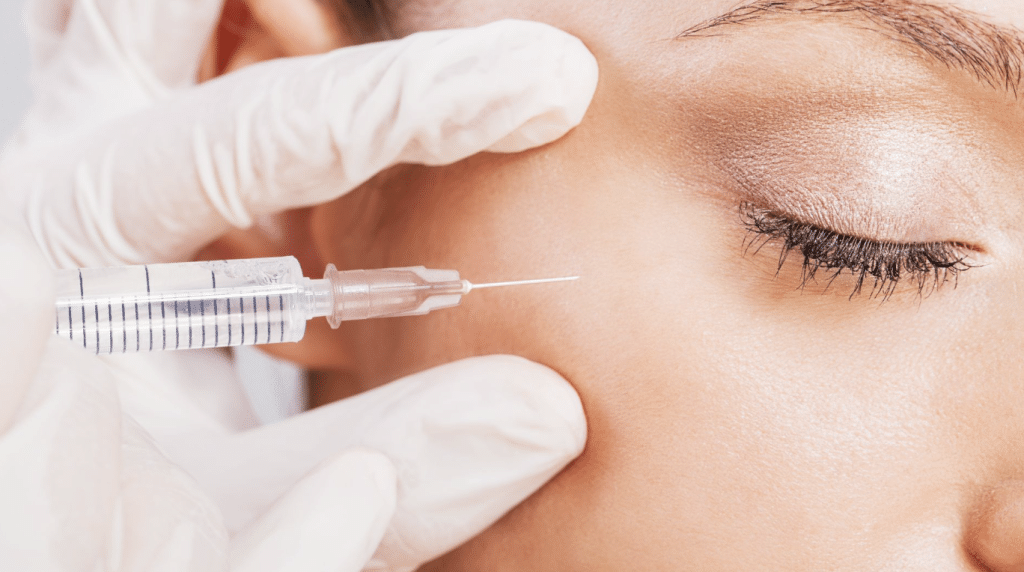Neurotoxin injections have surged in recent years, with global demand for botulinum toxin procedures reaching over 19.1 million in 2022. These treatments have become a go-to solution for reducing wrinkles and fine lines.
Among the popular Botox alternatives are Nabota and Dysport, which offer effective wrinkle-smoothing results. While they share similarities in their active ingredient, each product has distinct features that can influence your choice depending on your goals and skin type.
In this article, we’ll compare Nabota and Dysport, exploring their key differences, effectiveness, and what to consider when choosing the right option for your aesthetic needs.
Key Takeaways
- Nabota and Dysport are made from botulinum toxin and help smooth wrinkles by stopping muscles from moving too much.
- Nabota’s effects show in 2 to 3 days and last about 3 to 4 months, while Dysport can work in as fast as one day, with results possibly lasting between 3 to 5 months.
- Both treatments are FDA-approved for safety but may cause side effects like swelling, bruising, or muscle weakness. Rare serious side effects can also occur.
- The cost of Nabota and Dysport varies depending on the treatment area size and the number of sessions needed. Each has its dosing requirements, which affect the overall price.
- Patients choose between the two based on how quickly they want results, how long they want them to last, their budget, and personal experience with each product.
About: Medical Spa RX provides medical practices with premium products at the best prices. If you’re looking to buy Nabota for your practice, the sales representatives at Medical Spa RX can give you guidance.
Introduction to Nabota and Dysport
Neurotoxin products like Nabota and Dysport are derived from botulinum toxin, which temporarily reduces muscle activity. These treatments effectively smooth out wrinkles by limiting muscle contractions, making them popular for addressing signs of aging such as frown lines, forehead lines, and crow’s feet. They are also used to manage certain medical conditions involving involuntary muscle movement.
In recent years, Nabota and Dysport have gained popularity as alternatives to Botox. Both products have received FDA approval for specific indications, ensuring their safety and effectiveness in achieving youthful-looking skin. As demand grows for more customized and accessible wrinkle treatments, these two options have become go-to solutions for those seeking subtle, natural-looking results.
Composition and Mechanism of Action

Nabota and Dysport are both botulinum toxin type A products designed to reduce muscle activity and smooth wrinkles temporarily.
- Nabota: This product contains highly purified botulinum toxin with a streamlined formulation that minimizes unnecessary proteins, potentially leading to faster onset and longer-lasting results. It works by blocking nerve signals to targeted muscles, preventing them from contracting and thus reducing the appearance of wrinkles.
- Dysport: This product also uses botulinum toxin type A but has a different molecular structure and a broader diffusion area. This allows it to spread more evenly across larger areas, making it particularly effective for treating conditions like forehead lines. Like Nabota, Dysport inhibits nerve signals, relaxing muscles to smooth out dynamic wrinkles.
Clinical Efficacy

Nabota has shown significant efficacy in reducing wrinkles. A phase 4 clinical study demonstrated that Nabota effectively improved glabellar frown lines in 85.4% of subjects within two days of administration. The study also confirmed the safety and rapid onset of action of Nabota, making it a reliable option for wrinkle reduction.
Dysport has also been extensively studied for its efficacy in treating various conditions, including wrinkles. Clinical trials have shown that Dysport is effective in reducing the severity of cervical dystonia and upper limb spasticity. These studies highlight Dysport’s ability to improve muscle tone and overall appearance significantly.
When comparing the clinical efficacy of Nabota and Dysport, both products have demonstrated strong results in reducing wrinkles and treating muscle-related conditions. While Nabota shows a rapid onset of action, Dysport has been proven effective in a broader range of medical conditions. Both products are FDA-approved and offer reliable outcomes, making them viable alternatives to Botox for achieving a youthful appearance.
Benefits and Drawbacks

Nabota is known for its cost-effectiveness, typically priced 20-30% lower than Botox, making it an appealing option for those seeking wrinkle reduction without overspending. It offers quick results, often noticeable within a few days, and its effects last around three to four months, striking a balance between affordability and longevity.
Nabota’s formulation can be a favorable choice for patients who prioritize rapid onset and reliable outcomes, especially in treating moderate to severe wrinkles. Doctors still recommend patients compare this treatment with others, like Nabota vs Xeomin, to make sure they get the treatment most suited to them.
However, some patients might find it less practical, especially if they are new to botulinum toxin treatments. Though lasting three to four months, its effects may not be as long-lasting as Dysport, which can last up to five months. This shorter duration might require more frequent treatments, which could be inconvenient for some users.
Meanwhile, Dysport offers a longer duration of effect, often lasting up to five months, which can be more appealing for those seeking prolonged results. People see results fast, often within 24 hours, making it a quick solution for reducing wrinkles. Dysport is particularly effective for treating deep lines between the brows, providing a noticeable improvement in appearance.
But despite its longer-lasting effects, Dysport might not be as effective on lighter wrinkles as other treatments. Additionally, while it provides quick results, the initial cost might be higher than Nabota, which could be a consideration for budget-conscious patients.
Factors to Consider
- Onset of Action: Nabota typically shows results within a few days, while Dysport often provides noticeable effects within 24 hours. This quick onset makes Dysport a preferred choice for those seeking immediate improvements.
- Duration of Effect: Nabota’s effects generally last about three to four months, whereas Dysport can last up to five months. This longer duration may reduce the frequency of treatments needed with Dysport.
- Side Effects and Safety Profile: Both Nabota and Dysport have similar side effects, including mild pain at the injection site, temporary muscle weakness, and headaches. Both treatments are FDA-approved, indicating a strong safety profile when administered by a qualified professional.
- Cost: Nabota is often more budget-friendly. This cost difference can be a significant factor for those looking to manage their cosmetic treatment expenses effectively.
Conclusion
Choosing between Nabota and Dysport ultimately depends on your individual needs and preferences. Both are effective for smoothing wrinkles, but they differ slightly in how quickly they take effect and how long the results last. If you prefer faster results, Nabota might be ideal, while Dysport’s longer-lasting effects could be more suitable if you want fewer touch-ups.
Each option has its unique advantages and considerations. Consulting with a qualified medical professional is essential for determining which treatment aligns best with your goals. They can provide personalized guidance to help you achieve your desired results safely and effectively.
FAQs
1. What are Nabota and Dysport?
Nabota and Dysport are both popular Botox alternatives used in cosmetic procedures to reduce the appearance of wrinkles.
2. How do Nabota and Dysport work?
Both Nabota and Dysport work by temporarily relaxing the muscles under the skin, which can help smooth out fine lines and wrinkles.
3. Are there any differences between Nabota and Dysport?
While both products aim to achieve similar results, they may differ in formulation, duration of effect, cost, and potential side effects.
4. Which is better – Nabota or Dysport?
The choice between Nabota and Dysport depends on individual needs, preferences, and budget, as well as consultation with a professional healthcare provider who can offer personalized advice based on an individual’s situation.
References
Global Survey 2023: full report and press releases. ISAPS. https://www.isaps.org/discover/about-isaps/global-statistics/reports-and-press-releases/global-survey-2023-full-report-and-press-releases/
Choudhury, S., Baker, M. R., Chatterjee, S., & Kumar, H. (2021). Botulinum Toxin: An Update on Pharmacology and Newer Products in Development. Toxins, 13(1), 58. https://doi.org/10.3390/toxins13010058
Nestor, M. S., Arnold, D., & Fischer, D. L. (2020). The mechanisms of action and use of botulinum neurotoxin type A in aesthetics: Key Clinical Postulates II. Journal of cosmetic dermatology, 19(11), 2785–2804. https://doi.org/10.1111/jocd.13702





















